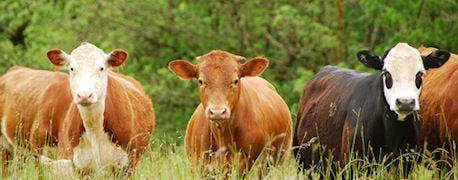June 18, 2014

Beef producers with wet pastures thanks to this week's storms may want to consider keeping a closer watch for hoof problems and internal parasites, a University of Arkansas at Pine Bluff livestock specialist says.
Livestock hooves soften if animals are pastured on wet ground or housed in damp pens for extended time, says specialist David Fernandez. Softer hooves are more susceptible to cuts, tears, or abrasions creating an opening for organisms that cause foot rot.
Fernandez says to keep foot rot at bay, avoid placing animals on hard or gravel surfaces until their hooves have dried out to reduce the likelihood of cuts, tears or abrasions.
Related: Lameness Impacts Beef Productivity, Welfare

Beef producers should look for increased incidences of hoof problems and internal parasites when dealing with persistent wet pastures
A tell-tale sign of hoof problems is lameness, so Fernandez advises livestock producers to examine animals' hooves. Foul-smelling odors, heat and inflammation at the coronary band where the hoof adjoins the pastern are signs of the disease. Producers should trim the hoof to remove damaged or dead tissue and then treat the affected food with one of the following:
• Antibacterial sprays (20% cetrimide and 1.3% oxytetracycline in water and alcohol)
• Footbaths (10% zinc sulfate,10% copper sulfate or 5% formaldehyde solutions)
• Footsoaks (1 hour in a solution of 10% zinc sulfate and 0.2% v/v of laundry detergent containing nonionic surfactants or the surfactant sodium lauryl sulfate)
Internal parasites
Wet weather also creates conditions favorable for internal parasites to infect animals on pasture. Liver flukes, which can cause significant economic losses in cattle, are more common in wet weather.
~~~PAGE_BREAK_HERE~~~
Barber pole worm, large stomach worm, wire worm, medium or brown stomach worm and small stomach worm are aided by wet weather. Scours, anemia and unthriftiness are common signs of a heavy internal parasite infestation, Fernandez says.
"Bottle jaw" – swelling under the jaw caused by fluid escaping from the blood vessels, is a serious indicator of barber pole worm infestation in calves. "Unfortunately, many dewormers used against barber pole worm are becoming ineffective," he says.
Related: Monitor Mineral Intake to Ensure Anaplasmosis Prevention
Wet weather creates conditions ripe for ticks. Some producers are already reporting high levels of tick infestations on their cattle, says Fernandez. Treat ticks with dips, sprays, pour-ons or ear tags. Tick bites can cause swelling, redness and localized infections.
"Ticks are also the primary transmitter of anaplasmosis, which causes severe anemia and can kill livestock in hours," says Fernandez. Older cattle are more susceptible to the more severe forms of the disease than are calves or heifers.
Infected cows may exhibit rapid weight loss, off-feed, incoordination, breathlessness and brown urine. Fevers up to 106 F may occur, and pregnant cows may abort. Anaplasmosis is treated with tetracycline.
Fernandez advises producers to consult a veterinarian for treatment options.
Source: U of A
You May Also Like




